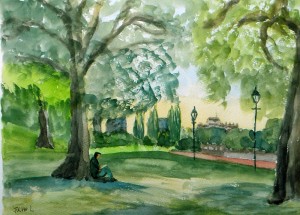How I compose a Painting
Here is an explanation
1) Planning or Preparation – 5 Minutes Max

My aim is always to create a route along which the viewers eye will travel. It’s how I compose a painting. They need to travel across and up and down the painting, until they rest at the focal point. The longer I can hold their interest, the more successful it might be.
Looking around, I notice an ugly old building, dominating a part of the scene. If it conflicts with my focal point or doesn’t add interest to my subject, then I can decide to leave it out.
There may be a tree right in the centre of my view, so what’s stopping me moving it to one side, where it could be used to good effect to frame the painting and to prevent the viewers eye from wandering off, out of the picture.
2) I drew quick tonal sketches with a 4b pencil or charcoal, Draw several 2 inch squares, and plot where the lights and darks will go, max 2 to 3 minutes.
Alter the lights and darks till one resonates.
3) Tonal and initial sketches – 5 Minutes Max.
In my sketchbook, I draw a rectangle about 3″ x 2″ and quickly put in the big dark shapes, then the mid tones. Leaving the highlights blank, (see above). For the most powerful effect, brightest lights go against darkest darks and vice versa, by squinting, I can determine what goes where. If my plan doesn’t work, I can do another, and darken a highlight or lighten a dark, remember that artistic licence! This is the time to make changes, before paint meets the paper.
When happy with this sketch, I’ll lightly draw the big shapes in position on my paper. I’m now ready to paint and its only taken me 15 minutes Max.

Because of this preparation, I know exactly how and what I’m going to do.
Furthermore, when the finished painting is eventually exhibited, the viewer will see the full range of tonal values, and their eye will hopefully be led. Unknowingly but deliberately, into the painting, and around it on a journey, until it settles.
They may or may not understand why, but my hope is that they will know that this painting works, it has some attraction, even better if it has made an ’emotional connection’.
That is important to an artist.
How do I know when a painting is finished? There is nothing worse than an overworked painting. So how to know? There is an article here that helps to explain a simple method, go check it out here
For an interesting article about choosing a subject, you will find this post helpful. It may even help with how to compose a painting.
